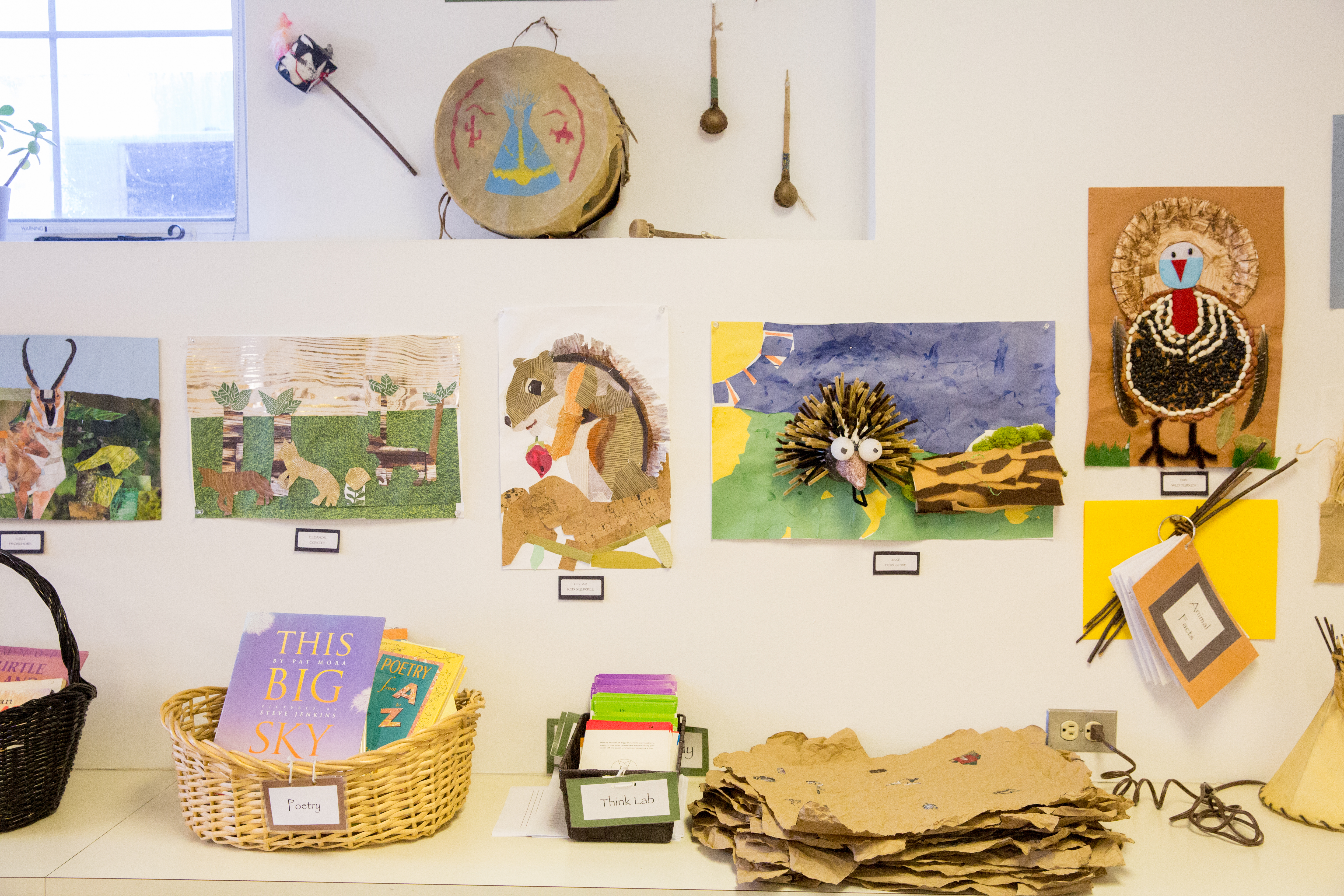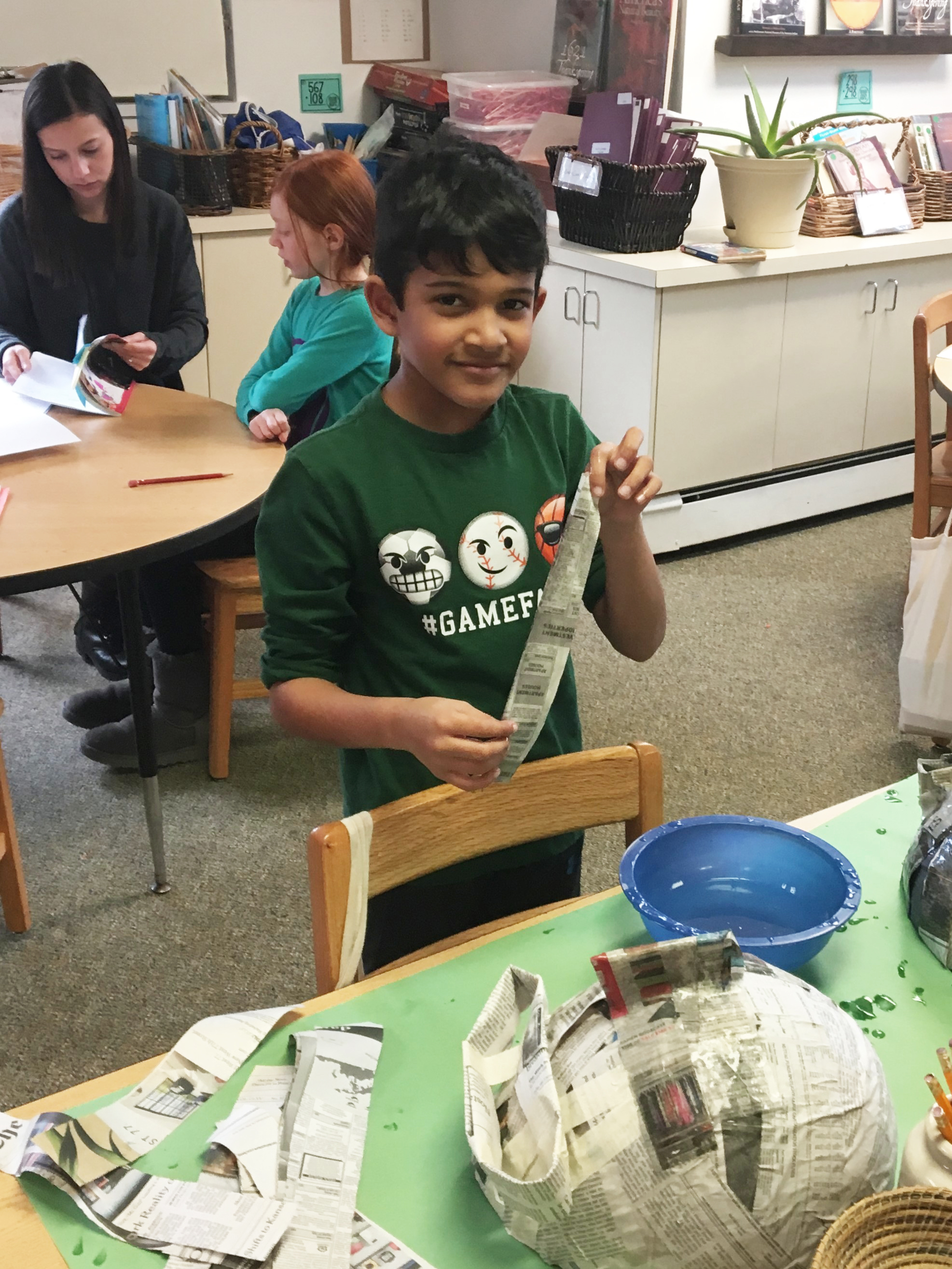Third Grade
The History and Culture of the Indigenous People Of The Americas: Whose Stories Are Told?
Core Curriculum
Third Grade is the culmination of the Lower School experience. Students learn to question and to consider multiple perspectives as they immerse themselves in the study of the culture and history of the Indigenous People of the Americas.
This yearlong core study creates opportunities for ideas, skills, and relationships to be developed slowly, thoroughly, and with the aim of fostering intellectual curiosity. Two overarching themes set the framework for exploration and reflection: Indigenous People’s view that humans are at one with, and exist in harmony with, all living things; and the ability of Indigenous People to successfully adapt their culture to widely diverse environments. Our core study of the Indigenous People of the Americas provides a natural forum for discussions about stereotyping, assumptions, discrimination, equity and social justice. As we move through the curriculum, we consider these essential questions: How did geography and environment impact the development of the people? How is culture preserved through storytelling? What contributions are honored and preserved? What is gained and lost? How does the past shape the present?
Literacy
Reading: Our curriculum utilizes a combination of a strong phonics program that augments the methods in the Reading Workshop. The program is designed to further develop independent reading, to increase comprehension, word recognition, and vocabulary usage, and to promote critical and analytical higher-level thinking. Book Clubs are a favorite experience in Third Grade. They allow for students to share their love of reading with their classmates and encourage leadership opportunities as they take on various roles for their meetings. Readalouds continue in Third Grade and are often connected to the Core and Social Justice curriculum. Reading in Third Grade encourages students to find joy, knowledge, and excitement in the books they read.
Writing: Third Grade continues to follow the Writing Workshop approach. Students work for longer periods on their personal narratives. With the guidance of their teacher through a conferencing method, Third Graders spend greater time on elaborating, expanding, and editing their own work. The Core Curriculum is integrated in their writing units when working on poetry, research, opinion, fiction and nonfiction. Cursive writing is continued and touch typing is introduced through our technology program.
Library: In Third Grade, students explore informational books in greater depth. While students have already developed a strong understanding of nonfiction text features such as captions, headings, glossary, and index, in Third Grade they are challenged to look more deeply at the underlying text structures most often used in nonfiction: problem/ solution, compare/contrast, and cause/effect. They continue to use non-fiction books as research tools as they investigate the accuracy of the historical events depicted in picture books. Third Graders have become expert library users and are welcome to start exploring the upper school shelves of the library in addition to the lower school shelves they have gotten to know so well in previous years.
Math
In Third Grade mathematics, students are encouraged to link past experiences to new concepts, become flexible, creative problem solvers, work cooperatively and discuss possible solutions, and apply mathematics to their everyday lives. The Third Grade math curriculum focuses on developing students’ deep understanding of mathematical concepts, proficiency with key skills, and ability to solve complex and novel problems. The Third Grade math curriculum aims to develop an understanding of multiplication and division and strategies for multiplication and division within 100; develop understanding of fractions, especially unit fractions; develop an understanding of the structure of rectangular arrays and of area; describe and analyze two-dimensional shapes. Students employ all work with increasing independence, focusing in particular on improving their mathematical communication skills, modeling with mathematics, and reasoning both quantitatively and abstractly. The greatest change for students is the move to more abstract thinking, attending to precision and persevering at problem solving.
Science
Third Graders have science class twice every week, and we focus on a variety of science topics throughout the year. Exploration of estuaries and ocean ecology, simple machines, force and motion, food chains and food webs, plant and animal adaptations, and climate change allow for a diverse experience in many domains of science. The students continue to develop their observation and communication skills, through research projects, observational drawings, written reflection, and simple lab reports. As they did in Second Grade, the students work with a partner, a small group, or individually in active, hands-on exploration. Our yearlong goal is to hone an understanding of the Earth as a complex and delicate system, made from many interconnected and interdependent parts.
Technology
Third grade is the first year that Far Brook students are each assigned their own Chromebook laptop computers. We begin the year discussing responsible use of and appropriate care for these devices. This discussion is followed by several lessons devoted to digital citizenship.
Early in the year third graders also begin developing their keyboarding skills, which they continue to work on throughout the year via typing.com. As the year progresses, students explore various productivity applications, such as Google Docs and Google Slides, which they will use more and more in various classes at the school as they advance from grade to grade.
Using a digital/physical educational game system that second graders at Far Brook students learn with, Osmo, third graders expand their understanding of computational thinking concepts to create short musical compositions with Osmo’s Coding Jam. The class then moves from physical blocks to block-based, visual programming with ScratchJr. Towards the end of the school year students further explore concepts in computational thinking by working in small groups to code and interact with Dash robots.
World Languages
French and Spanish classes follow as closely as possible the process by which children acquire their first language. The children are immersed in a language-rich environment made comprehensible through the use of body language, visual aids and abundant repetition in a variety of contexts. The teacher uses mainly story-based activities to bring the language to life. Through careful scaffolding of new and recycled words the children acquire a foundation of basic vocabulary, and simple useful phrases. In a typical lesson, the children engage in conversations on topics related to their immediate environment or interests. It may also include a variety of story-based and hands-on activities, music, and movement. Students are given multiple opportunities to use their language skills.
Performing Arts
Music: In Third Grade, students embark on a practical application of their music literacy to an instrument: the recorder. Evidence of recorder type instruments have been found in almost all native cultures as far back as the prehistoric ages. The recorder’s appeal for this age group lies in its gratifying accessibility (it’s fairly easy to play and to apply concepts) and in a sound that children can relate to (the recorder possesses a timbre and range similar to children’s voices.) Native-American, early American, and African-American folk songs and games, many of them pentatonic, lend themselves nicely to the recorder and tie in well to the Third Grade core curriculum. The recorder ensemble performs in Morning Meeting and at Instrumental Night with the Second Grade as part of the Lower School Philharmonic. Students learn how to work independently towards common long-term goals, by establishing good practice routines at home. Students continue expanding their solfège, rhythmic, structural and vocal understanding through Far Brook songs, songs of diverse world cultures, classical repertoire, and jazz.
Junior Strings Orchestra: Students in Grades 1-4 are invited to join the Far Brook Junior Strings Orchestra once they reach a certain level of proficiency in their musical skills with violin or cello. The Orchestra plays in Morning Meeting. Many students who participate in Orchestra also perform in the annual Recital Night in the spring and progress to the more advanced Orchestra for Grades 4-8 which incorporates more students, a wider range of instruments, and more challenging repertoire.
Dance: The Third Graders create dances based on Native American customs and culture, considering the ceremonial and social aspects of dance and how to re-interpret this in a modern setting. Using the knowledge of classroom study and their previous dance knowledge, students work collaboratively in small groups to create original work to reflect upon the history and culture of the Indigenous People, and present their work in performance as a part of a larger group work. Considering rhythms and creating their own music using claps, snaps and other body percussion as well as voice, the Third Graders continue to develop a sense of personal artistry and performance.
Fine Arts
Art: The Third Grade art curriculum focuses on the iconography and applied arts of the indigenous people of North America. In Third Grade, students are introduced to the visual beauty and importance of Native American art and design. From basket design to architecture and engineering, Third Grade students are exposed to the master craftsmanship of Native American men and women. Inspired by the work of textile artisans, students design and create unique hand-woven tapestries, honoring the sacred 4 elements: Earth, Water, Air, and Fire. Students are introduced to traditional techniques of loom weaving, while learning about the cultural and historical significance of weaving.
Design Thinking and Woodshop: Third Grade students continue to think deeper about design as it applies to the Far Brook community. They are tasked with re-thinking an area of the school that they are familiar with, like the playground or the woodshop classroom. They then build a model or a prototype of the product they think would improve these areas of campus. Additionally, an integrated project is created to go along with the core curriculum of the indigenous people at the close of the year.
Social and Emotional
Through weekly classroom meetings, Third Graders continue building upon and practicing the social/emotional skills and strategies they learned in Second Grade. The essential skills that are developed relate to five key areas: self-awareness, self-management, social awareness, relationship skills, and responsible decision-making. Children further develop skills needed to be good learners and to form healthy positive relationships.
Sports
Third Grade students continue to develop basic motor skills and sport-specific skills through participating in games and activities in Sports class. Sportsmanship, team play, and fair play are an emphasis throughout the year. The importance of character development is refined and becomes an expectation. Third Grade students rotate through units of soccer, floor hockey, team handball, basketball, and kickball/wiffle ball. Every month the students are introduced to a Sports Changemaker which is an athlete that makes a difference in the world through fighting for social justice, fairness, and equality.



